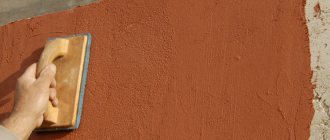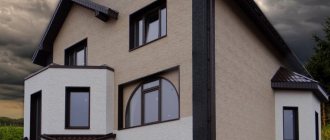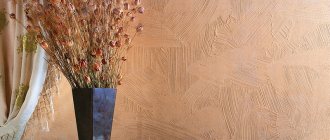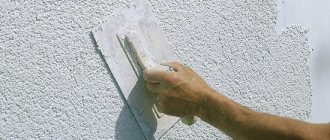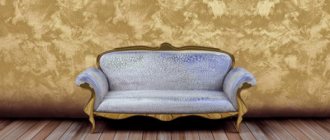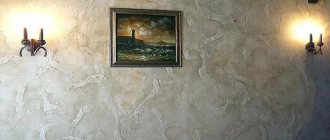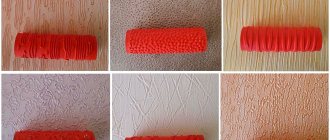Every homeowner wants to see their home beautiful, well-groomed and unique. The good thing is that the use of modern building materials makes it possible to realize most of his fantasies. The entrance hall can be called the face of any home, be it a country residence or a city apartment. Guests form their opinion about the house often under the impression of the hallway and its appearance. And that’s why interior designers pay special attention to it.
Decorative plaster in the interior in the hallway.
For its finishing, many materials are used, and not the least important role among them is played by decorative plaster in the hallway. What it is, how to prepare it and put it into practice, we’ll talk about all this below.
What should the plaster be like?
An example of decorative plaster in the interior.
Plaster composition is essentially a mixture based on a number of components (cement, clay, sand), which is used for the final finishing of walls and ceilings. But, it should be understood that such plaster is fundamentally different from general construction plaster, used for rough processing of walls and ceilings.
Decorative plaster in light colors.
Decorative natural plasters are multilayer coatings that include at least two layers. The first layer is a primer, it must be compatible with the wall material. That is, one primer is used for brick, another for wood, etc. For final finishing, a mixture is used, which consists of a binder component that is saturated with various types of fillers.
Advantages and disadvantages of decorative plaster when decorating the hallway
Decorative plaster is popular today; it gives a lot of opportunity to get creative. This coating is several millimeters long, and the color scheme and texture are varied.
Dirt from the street rushes into the hallway, so the finishing material for the walls must be wear-resistant and washable. Decorative plaster meets these requirements perfectly.
Main advantages:
- practical, strong, durable - if applied correctly it will last a long time;
- resistant to external influences - not afraid of water and detergents;
- frost-resistant;
- universal - can be applied to any surface (brick, wood, metal);
- has camouflage qualities - you can level walls and mask cracks;
- environmentally friendly, non-toxic - consists only of natural ingredients;
- has heat and sound insulating properties;
- Only the damaged area can be repaired.
Despite all the advantages, decorative plaster also has disadvantages - it is expensive. In addition, applying it requires skill, and dismantling time and effort. Also, the surface before application must be clean and treated with a primer.
Types of plaster
Venetian plaster in the design of the corridor.
When carrying out finishing works, the following types of decorative plaster are used:
- Ordinary monolithic plaster;
- Terrasite;
- Venetian;
- Bark beetle;
- Modeling and many others.
Textured plaster in room design.
Terrasite plaster is intended mainly for exterior finishing. But in the modern building materials market, where plaster of this type is presented, there is also one adapted for indoor use. It consists of Portland cement, limestone flour and quartz; there are other compositions, for example, which include mica crumbs.
Types of terrazite plaster for finishing.
Venetian plaster includes stone flour. Usually marble is used to obtain it. In addition to it, granite, malachite, etc. are used. It is added to the finished plaster mixture and then applied to the prepared wall.
Wall decoration with Venetian plaster.
Corridor plaster of the bark beetle type is available in two versions - acrylic and gypsum. The first plaster is a ready-to-use mixture. The gypsum composition is a mixture that will need to be prepared for use. It includes marble granules or mineral chips. Their size determines the grain size of the material and its appearance.
Structural paint and flocking
Example of structural paint for wall covering.
One of the new building materials is structural paint, sometimes called textured paint. Recently, it has become widely used for finishing work. This paint allows you to create any pattern, and thus can be used instead of wallpaper. But this material has a significant drawback - high cost. On the other hand, its service life can be counted in decades, and this will more than pay for its costs. What distinguishes it from ordinary paint is not its composition, but the method of application to the wall surface.
Flock is a filler that is added to paints to create a more impressive look. To obtain it, wool, cotton, etc. are used; it is also made from polymers.
Designer varieties of plaster
In addition to such a criterion as composition, decorative plaster is divided into several types, distinguished by appearance.
Venetian
The most luxurious type of decorative plaster is Venetian. It can harmoniously fit into any interior, becoming a decoration of the corridor. But most of all, this finishing material is suitable for a classicism or baroque style interior, turning your home into a real palace.
Venetian plaster consists of lime, marble or onyx chips, so a wall finished with it looks practically no different from natural stone. Using paint, you can give this finish any shade you like. The mixture is sold in small buckets and is a thick mass.
A wall finished with Venetian plaster can be made matte or glossy. To achieve the most effective option, the master applies the mixture in several layers using a flexible rubber spatula. Each new layer is applied only after the previous one has completely dried. It is better to entrust this work to a professional. Finishing with Venetian plaster is expensive, but the impressive result fully justifies the price. A photo of the design of Venetian decorative plaster in the hallway can be seen below.
Structural
This type of finishing is distinguished by the presence of various minerals in small parts: quartz, marble and others. After its application, the surface of the wall acquires an unusual relief. The heterogeneous mixture is spread on the wall with certain movements, creating an original pattern. This material allows air to pass through and is not afraid of moisture; it is sold ready-made and can be painted on the wall.
Structural plaster is used both for finishing external walls and for interior work. To finish the corridor, you can choose a water-based mixture. It dries quickly and has no odor. The finished wall is not afraid of mechanical damage and wet cleaning.
Textured
This finishing option, like the structural one, creates roughness. The filler for it is: mica, wood, flax fibers, small pebbles. By mixing different shades and using special tools, surfaces are created that imitate leather, fabric, natural wood, and stone.
Textured wall material is easy to apply, does not require leveling, and hides most irregularities. It forms a hard surface that is permeable to air and resistant to moisture. This material is available in dry and ready-made form. You can apply textured plaster in the hallway with your own hands, as shown in the photo, without the use of specialized tools and without involving professionals.
Subtypes of textured plaster:
- Bark beetle The composition includes small pebbles. There are grooves on the wall that resemble wood eaten away by bark beetles. A photo of textured bark beetle plaster in the hallway interior can be seen below.
- Fur coat. The mixture, made on the basis of cement, forms a rough texture with a fleecy effect.
- Lamb. It contains stone grains. When applied to a wall, it forms a surface that is rough to the touch and evenly grained.
Flock
It contains silk fiber and cellulose, making the wall look as if covered with silk. This design looks expensive and elegant. The surface of the wall shimmers beautifully. At the same time, it is moisture resistant and provides good sound insulation.
Sea breeze
Made from acrylic. Additional fillers are particles of pearlescent pigments and river sand. It creates the effect of light clouds or sand in the desert. Available in several colors: gold, pearl, bronze, garnet, white, chameleon.
Latex plastic
The finished version of the smooth glossy finish looks like Venetian plaster. It imitates polished stone. The matte version has a relief texture. This finishing material is resistant to cracking, is not afraid of water, and can be cleaned with a damp cloth.
Combination of finishing materials
Combination of decorative plaster and wallpaper in the hallway.
Textured plaster is often laid at the bottom of the wall. It is most susceptible to contamination; the upper part can be covered with wallpaper. The columns are finished in the same way.
Textured plaster is a beautiful material, and if you divide a wall using a baguette or plinth and apply mortar, it will be possible to get the illusion that the walls are covered with marble or other finishing stone, for example, malachite.
The combination of several types of coatings in one space allows you to decorate the wall as a full-fledged panel. By the way, this move is used by designers when decorating and decorating spacious hallways or halls.
Decorative plaster and its application to the wall
First, textured plaster is applied with a spatula; a relief texture is created using rollers, stencils or spatulas. For some textured plaster compositions, a spray device is used. Using unexpected objects to give relief to the plaster layer will give an original effect, for example, a shoe brush, a crumpled plastic bag, a twisted leather belt or the surface of an old children's toy can pleasantly surprise you in creating a relief effect for textured plaster walls. It is important to complete the formation of the relief within 35-40 minutes. After the relief layer has completely dried, grouting and cleaning of the surface from burrs are carried out. The wall is painted in the desired color.
Bright hallway design with textured plaster
Light hallway design
Advantages of decorative plasters
DIY bas-reliefs made of plaster on the wall.
This finishing material has gained wide popularity due to the fact that it has a number of undeniable advantages:
- Decorative plasters in the corridor are laid on the wall quite easily. But this requires strict adherence to the instructions for using ready-made formulations.
- In order to lay it on the wall, you only need a trowel, spatula or roller.
- The main difficulty when laying the composition is careful preparation of the wall. But more on that below.
- The use of this type of plaster masks almost any wall defects. Once it's in place, even the most wavy walls will look like it was intended by the designer. But the walls still need to be prepared early.
- In addition to decorating the walls, this composition acts as thermal insulation. To do this, it is necessary to treat the walls, and the solution must be of a certain type. By the way, some manufacturers produce and sell special compounds with enhanced thermal insulation properties, which can take on the function of insulating a room (corridor).
- Today, the use of decorative plaster allows you to create non-traditional types of interior design for the corridor. Moreover, the use of this material guarantees that the created interior will be unique.
- A wide selection of plaster of this class allows it to be used in various styles from empire to high-tech.
- For the most part, this material is environmentally friendly. It contains natural materials that are safe for humans. It does not absorb odors and does not emit any substances that could harm residents or pets.
Venetian
All the features of rocks are brilliantly conveyed by “Venetian” - perhaps the most popular plaster in recent times. It is universal and quite varied, so you definitely won’t get bored after making this choice.
Not convinced? Maybe it will turn out like this: one of the most beautiful projects with the “participation” of decorative plaster, distinguished by the balance of the depicted details and an extraordinary atmosphere. Well-placed light creates a beautiful illusion of gilding on the walls. Most ladies will appreciate it, I suppose.
Not everyone knows, but plaster can be painted any color you like. Apparently, the owners of this hallway are well aware of this and have already managed to choose the right color based on temperature and shade.
What is natural is not ugly. And we will even say more: it’s wonderful. Probably, this amazing naturalness of the dominant pattern is where the special appeal of Venetian plaster lies.
An elegant and aristocratic version of the hallway. The room is bright, cozy and not the least role in this is the plaster applied to the wall.
Preparing the wall for decorative plaster
Various drawings and landscapes on the wall are made using decorative plaster.
Laying plaster is the final stage of construction work in the hallway, and its implementation requires certain skills. That is, the installation of door and window structures must be completed, the work associated with rough processing of the walls and ceiling must be completed. The corridor is cleared of construction debris and associated dirt.
Combination of decorative plaster and stone in the interior.
Preparation for plastering is similar to preparation for painting. The wall must be leveled, scratches, chips, and potholes must be eliminated and covered with acrylic-based primer. If the surface being prepared is not dense enough, then it must be treated with either a strengthening compound or a restorative primer. The soil not only strengthens the wall, but also provides protection from excess water and increases the adhesion of the coating to the base. When preparing the wall, it is treated with antiseptic solutions that resist fungus and harmful microorganisms.
Detected cracks are “opened” and sealed with a special solution.
The primed surface is puttied. This operation is repeated several times and each layer must dry for about 24 hours. To protect the surface from cracks, serpyanka or non-woven wallpaper is used. The places where their strips meet must be carefully puttied.
Decorating the hallway walls with decorative plaster.
A deep penetration primer composition made on an acrylic base is applied to each layer of putty. When preparing the base for laying the composition, it is unacceptable to use materials based on alabaster. For grinding, use abrasive paper with fine grain.
Before you start painting, you need to do a test. This is necessary in order to evaluate the quality of the coating texture.
Compound
Now bark beetle is not a specific mixture, but a pattern that is formed by decorative plaster. Therefore, the composition may be different, and even the size of impurities varies from 0.8 to 3.5 mm. It is the additives that determine how deep the pattern will be, so very small particles up to 0.5 mm are not used - there will be no desired effect.
Coarse-grained plaster is often used for facade work, and fine-grained plaster is often used for interior work. This is how you get the same effect of a surface streaked with beetles. The drawing partly resembles a not very neat cut of an old tree.
Cement-based bark beetles are traditionally produced in white and tinted with pigments. After application, the plaster can be painted over with water-based or silicone paint. The coating is resistant to moisture and frost, cheaper, but lasts less.
Polymer bark beetle plasters are more durable, do not crack and require minimal preparation of the base. They are easier to work with and more convenient to color, because they are an acrylic composition. But the vapor permeability of the polymer mixture is lower and it is more expensive.
Less common are silicate and silicone bark beetles. Silicate ones include water-repellent impurities, are suitable for wet rooms and are rich in different shades. Silicone is the most durable and crack-resistant, but the most expensive.
Decorative plaster (50 photos): types and composition, how to apply
Plaster application technology
Drawing a pattern on decorative plaster.
Laying plaster is not a very complicated process. At least no more difficult than working with traditional materials. But the cost per square meter of its creation can reach several thousand rubles.
But as practice shows, a lot depends on the parameters of the mixture. You can buy mixtures with different characteristics on the market, and it is quite enough to strictly follow the instructions, which are always on the packaging.
Application rules
The decoration of the hallway with decorative plaster is carried out using different technologies.
- Mosaic plaster is applied in one thick, even layer. It is heavy, hardens slowly and is practically impossible to adjust.
- But the “wet silk” , on the contrary, is very easy to handle. They apply it with a spatula, crosswise, without even trying to maintain uniformity.
- Finishing with Venetian plaster requires high qualifications. Each layer is applied after the previous one has dried, usually after sanding. The work is long and takes a lot of effort.
- “Bark beetle” or “lamb beetle” are easy to install. Here you only need to fulfill the standard requirements: apply the mixture from top to bottom, from the window, carefully level it with a grater. Usually 1 coat is required. The surface can be adjusted within 30 minutes.
Preparation of walls and mixture
The primer increases the strength of the wall and improves adhesion.
The wall is not leveled to match the texture or structural composition, unless, of course, it contains defects larger than 15 mm. Volumetric mixtures fill cracks and chips and compensate for curvature. Under the Venetian, the wall or ceiling must be perfectly smooth.
are primed for decorative plaster - this is mandatory.
Mix the composition according to the instructions. The methods are different.
Application technology
The method of application is determined by the type of plaster.
- Textured decorative plaster in the hallway is usually applied in 2 layers : the first is the main one, it masks defects and creates a base. The second layer is thinner. Often the layers have different shades: then the created relief acquires depth. While the 2nd layer has not dried, decor is applied. Roll with a rubber roller with a pattern, apply stencils, apply relief with a sponge or cloth.
- Structural plaster is applied in 1 layer. Here the texture is formed when applied with a regular spatula. Therefore, the finishing does not require any additional manipulations.
- The technology for applying Venetian plaster is much more complex. The material is applied in a thin transparent layer. Sanded and often waxed. The number of layers varies from 3 to 15 . The more layers, the more interesting the decor of the walls and ceiling.
How to apply plaster on walls correctly
Applying plaster in a thin layer.
Thin single layer coatings
They imitate fabric trim. These compositions are applied to previously prepared surfaces and have a minimum permissible thickness. This coating looks like fabric. This composition is applied with a brush. The solution contains polymer binders and crushed filler (glass, metal-based pigment, etc.).
"Fur coat"
Decorative plaster for walls view-fur coat.
After applying this composition, a rough, gray surface is formed on the wall. Its color can be adjusted with tinting additives. To obtain the texture, the finished solution is spread with a trowel and leveled with a wide spatula or steel trowel. This is considered to be the simplest form of plaster texture. To achieve the final appearance, a textured material, such as a brush or a piece of faux fur, is applied to the area of the wall where the coating was recently applied.
When the applied layer is ready, it is covered with a varnish coating.
Corridor design
Original design options for corridor space.
Under concrete
Decorative material with imitation concrete not only has a very stylish appearance and goes well with other types of decoration, but also has many positive technical qualities that make this finish truly universal and easy to use. The matte concrete surface in the room looks very delicate and unobtrusive.
The photo shows a corridor and decorative wall decoration using plaster with an imitation of a concrete surface.
Marble
Decorative finishing that reliably imitates precious stone can be presented in a wide range of colors. The coating with marble chips reflects the stone texture as accurately as possible and gives the corridor a luxurious and presentable appearance.
The photo shows the hallway and plaster with imitation black marble.
Silk
Thanks to the mother-of-pearl threads in the composition, this surface shimmers with a silky sheen and visually resembles natural fabric. In addition, this finishing material is moisture resistant, easy to clean and can be painted in any shade.
Craquelure
With the help of such an imitation of an aged, cracked surface, you can create a unique and extravagant design and add special uniqueness to the interior.
Bark beetle
It has a recognizable grooved texture with a specific unique pattern, which is created by special granules. Bark beetle will not only look extremely unusual in the hallway, but will also be a very light, practical and durable material.
Colored
Variations with 2 or 3-color decorative coating allow you to create an interesting and extraordinary design. Multi-colored combinations decorate the decor and make it more expressive.
Paintings
A fairly popular type of decoration, with the help of which you can implement the most non-standard solutions and add special originality to the interior.
Under the brick
Thanks to the imitation of facing bricks, you can create the illusion of real masonry in a room. Various decorative techniques allow you to give the textured finish a careless, deliberately rough or neat and geometrically adjusted appearance.
The photo shows decorative white plaster imitating brickwork in the hallway.
Combined walls
Thanks to the combined walls, the room takes on a more interesting, stylish and cozy look. Decorative plaster harmonizes perfectly with other types of finishing materials, for example, wallpaper, painting, wall plastic or wooden panels, brick or stone masonry and others.
The photo shows a modern corridor and decorative black plaster combined with a white painted surface.
Some subtleties
A beautiful combination of wallpaper and plaster for the walls.
When performing plastering, it is advisable to take into account the following subtleties of work:
- Mixtures containing large solid particles are applied by hand;
- Water cannot be added to prepared formulations;
- When choosing a water-based composition, you must remember that they are more susceptible to damage, excessive humidity and temperature fluctuations;
- If the period of use has passed or the storage rules were not followed, then the plaster in the corridor may not fit on the wall.
Mastery Technologies
Antique
To work, you will need standard tools: roller, spatula, stencil paper. And for the final stage: wax, whitening gloss and a special product that fixes the plaster. The selected mixture is diluted according to the instructions.
In order for the plaster to last for a long time, certain conditions must be observed before starting work:
- humidity in the corridor should be minimal;
- temperature during operation is 20 degrees.
The process includes the following steps:
- plaster is applied;
- relief is created;
- painted;
- processed with wax (Venetian version).
After cleaning the walls, apply the selected mixture (5 mm thickness) using a large spatula. Movements are made evenly up and down, taking into account the selected pattern. Then the pattern is made using a small spatula, roller or stencil. Until the plaster has completely dried, excess particles are removed; this can be easily done with plain water.
The fillers included in the plaster almost immediately form a pattern after it is applied to the surface. The complete drying process occurs within 3 days.
The simplest way to apply relief plaster is with a roller with a cloth wrapped around it. It is necessary to roll over the surface with putty applied using a roller, applying force. A relief pattern can also be obtained using improvised tools: a shoe brush, a broom handle, it all depends on your imagination.
It is possible to apply the mixture in several layers, but it is important to carry out this work within half an hour, until the surface hardens. After final drying, it is processed with a float and painted (if necessary). The paint can be water-based acrylic.
To make the wall look even more dazzling, it is recommended to rub it with wax, which is then rubbed with a damp sponge.
Patterns for decoration
In addition to the basic parameters of this class of plaster, there is a set of techniques that can be used to decorate the walls in the hallway.
Stencil designs
Decor on plaster using a stencil.
In modern terms, painting is a trend in modern design. To obtain it, a template (stencil) is used. Painting can be applied to any surface. It allows you to make a repeating pattern on the entire wall. The painting can be further processed, for example, subjected to artificial aging.
Volumetric drawings
Drawing three-dimensional designs on plaster.
Before creating it on the wall, it is advisable to make a preliminary sketch on paper. These drawings are different in that they have a 3D effect. Such a design can be included in a large wall painting or can be made as an independent composition. It is better to invite a professional decorator to perform it.
In fact, methods of decorating wall coverings are not limited to the examples given. There are many more of them, for example, imitation stone.
Which one to choose for hallway renovation: types of design
Venetian
The finish resembles marble in appearance but is a seamless interior finish that can be finished in a high-gloss finish or fill the room with a semi-gloss texture. You can choose a relief or smooth surface, using varieties and analogues of stones (amber, malachite).
Advantages of decorative finishing in the corridor:
- strength;
- durability;
- safety;
- environmental friendliness.
Important
The appearance of the Venetian covering is very beautiful and creates a stunning visual effect in the room. The only drawback of this coating is the high price. Do-it-yourself Venetian finishing takes a lot of time, since laying the material is very labor-intensive. It's better to hire a professional.
Venetian plaster comes in several types. They differ in the type of finished coating, composition, and method of application. Among them are the following.
Craquelure
Creates an antique effect, fancy patterns, decorative cracks across the entire surface.
Carrara marble
Finishing with iridescence, the effect of which is achieved by applying several layers one after another.
Veneto
The surface looks semi-matte or like polished marble.
Marseille wax
The wax coating creates an interesting effect, which is clearly visible under artificial light.
Trevignano
A special play of light due to the polymer mixture and skillful application technique.
Marbello
Outwardly it resembles velvet with streaks of gloss. Color diversity is achieved through iridescence. This can be observed especially clearly in sunny weather.
Encausto
The surface looks like granite. It is matte, so an additional layer containing wax is applied on top.
Textured
Mixtures with fine-grained filling, delicate consistency, and manageability during installation. Textured plaster creates flat or embossed surface finishes. When dry, this material does not shrink. The color and technique of applying strokes to the plaster mortar are important to create the correct imitation and an amazing result.
Attention
The textured material is moisture resistant, protects the walls from the penetration of water and fumes. Many imperfections on the surface are hidden under a small layer of the mixture. The finish has a relief pattern with a unique combination of colors, light and shadows.
Advantages of textured plaster:
- strength;
- durability;
- versatility;
- environmental friendliness;
- seamless coating;
- soundproofing;
- camouflage effect;
- decorative appearance;
- uniqueness.
Structural
Has modeling components. It has different geometries, a variety of colors and structural components. Contains:
- crushed stone or rolled stone chips;
- granules of synthetic or ceramic filling;
- shell fragments;
- fibers;
- metal dust.
Finishing mixtures of structural plaster for corridors are selected depending on the composition. Divided:
- mineral structural plaster with a binder base of cement and lime;
- acrylic (or latex).
There are two more varieties that are successfully used for finishing work - these are:
- silicate structural plaster based on liquid glass;
- silicone, including a polymer composition.
Benefits of coverage:
- excellent quality of application - all the smallest irregularities, defects, cracks, chips are hidden;
- giving the surface volume and relief;
- ability to adhere to any base (wood, brick or concrete);
- high heat-insulating, waterproof qualities;
- good mechanical strength;
- practicality, ease of care;
- rich palette;
- breathable structure;
- ease of application.
Among the negative points:
- Solidity of finishing with structural decorative plaster.
- When changing the cladding, it requires thorough leveling.
- There should be no defects left, otherwise the work will be done in vain.
- The weight of the coating is significant - up to 4.5 kg per square meter.
Artistic
The finished plaster mixture contains inclusions of large particles. Get the effect of unevenness, level the final layer with a spatula or roller. Silk fibers, cellulose, and dyes are added to the composition, which recreate the texture of silk, velvet, and other beautiful structures. At the same time, excellent sound insulation and heat retention inside the room are observed.
Important
Artistic plaster is easy to use and does not require filigree precision. A smooth surface is achieved by adding viscous components to the composition. Under their influence, the bends of the application layers mask unevenness and look impressive.
The most popular are the following.
Large-relief composition
Plaster looks very elegant on the walls and ceiling of any type of corridor. This style allows you to combine different interior options.
Traditional
The effect of these compositions is simply mesmerizing. After the finishing layer has dried, various visualization effects can be observed. This can be an imitation of fabric, silk, wood, stone, granite or marble image. Paint with a silver or golden tint is often used.
High tech
Design with straight lines outlined by borders. The minimalism of the decor is stunning. Metal inclusions and finely crushed glass give the effect of gray and white tones with reflections of a metallic color.
Antique
Special painting techniques and a pronounced surface texture create a unique effect of the passage of time. Artificial latexes give the surface a rough base when it dries completely. In places of greater friction, the impression of a brightened space is created. When drying, a microporous film is also created, which effectively protects the surface from the influence of temperature changes, moisture, and mechanical damage.
Advantages of this type of coating:
- Versatility. Structural painting looks great on walls, ceilings, and hallway slopes.
- Moisture resistance. Feels great and does not deform due to temperature changes.
- Strength.
- Fire resistance.
- Environmentally friendly. There are no toxic or polymeric substances that can cause health problems.
- Ease of care. To clean the surface, you can use any cleaning products, except for preparations with an organic composition.
- Durability.
Advice
Using antique decorative plaster is very beneficial. With long-term use, any errors will look impressive in this style. You can update the interior over time and change its appearance. Several layers on top of each other will not affect the quality of the drawing in any way, but will make the effect of antiquity more complete.
Flock
Flock coating consists of small filler plates of different shapes with uneven color. You can find bright or muted colors. It can shine or, conversely, give off a matte sheen.
The plates that are added to the composition sometimes have a glowing effect. Light emission is achieved through flocks of different fractions and proportions. The unique texture and heterogeneous color of the texture are the undoubted trump cards of this type of decorative plaster.
Plaster of this quality and composition has increased moisture resistance. Its smooth surface does not accumulate dust in uneven areas. There is great similarity with other types of decorative plaster, but there is no toxicity or restrictions in use.
This coating is suitable for corridors, as flock plasters retain a fresh look for a long time. Hygiene and moisture resistance create comfort and ease of care. The walls and ceiling do not need frequent cleaning. The maximum that can be done is to lightly wipe the surface with a damp cloth, even without detergents. Dust and dirt are easily removed with one touch.
Silk
The composition of silk decorative plaster includes cellulose, silk and cotton fibers. Advantages of silk coating:
- Unique texture. Mother-of-pearl shine gives a decorative shine and an absolutely elegant ornament.
- Seamless performance.
- Long service life. With careful adherence to application technology and careful operation - 10 years or more.
- Environmentally friendly. Does not contain toxic substances.
- Amenable to careful repair without special skills. There are no problems when repairing defective areas. All work is carried out as carefully and quickly as possible.
Among the disadvantages are the high price, mandatory thorough, thorough preparation before repair. High air permeability of the dried coating is noted when the walls absorb odors very strongly. If the surface is damaged, the appearance deteriorates greatly, but repairs are quite easy to do.
Choosing plaster for the hallway
When choosing which type to apply in the hallway, you need to figure out what their differences are:
- Acrylic. Immediately ready for use, applied to any type of surface, highly plastic. The original color is white; to change it, they resort to tinting or painting the already applied coating. It is possible to carry out repairs yourself.
- Mineral. Before work, it is necessary to prepare a mixture that is very strong due to the cement in the composition, and has an adequate price. Resistant to damage, but requires speed and compliance with application rules. Suitable for classic designs.
- Silicone. The “youngest”, but most satisfied, is popular due to its excellent characteristics: it fits well on walls due to its high elasticity, retains its original appearance for a long time, does not fade, with its help you can create any of the possible effects, has many colors in stock, although the price is reasonable high, but justified by a long service life.
- Silicate. It contains harmful substances and sets quickly, which requires a high rate of work. Beginners may not be able to cope with such a task. Narrow range of colors, but low price.
The buyer’s choice depends on his personal preferences, but plasters with an acrylic, mineral and silicone base have proven themselves to be the best.
Examples of interior design in the hallway of a house or apartment
Various styles and design options are inherent in decorative plaster, which is applied in the corridor. The most interesting interior options are as follows.
Country
The interior of the hallways perfectly combines the colors of nature : drawings of trees, hills, bushes, rivers, lakes or imitation of the countryside. The most spectacular are yellow and green tones, which always dominate.
Fusion
The combination of incompatible things is perfectly defined here by installing doors in the Empire style or arranging Venetian chairs in a chaotic manner. Some fragments use rather unusual combinations of glass, tiles and metal.
Antique decoration
You can create an aging effect by emphasizing details. For example, an image of a waterfall against the background of an old destroyed building. But you should not greatly optimize the drawing itself. The tones must be barely defined to create the desired design and realize the fantasies of antiquity.
